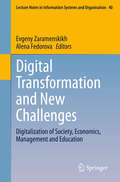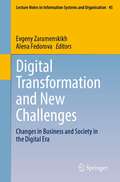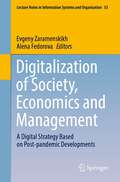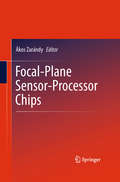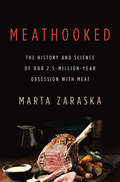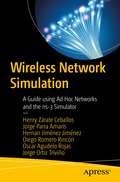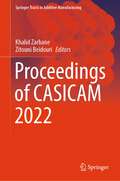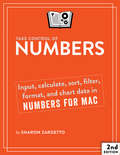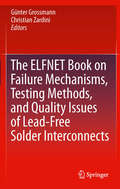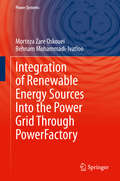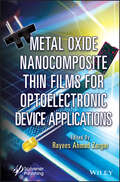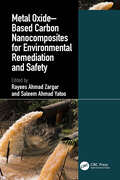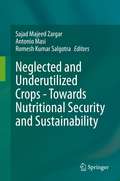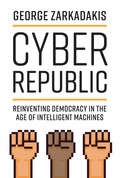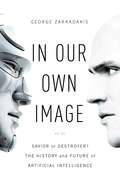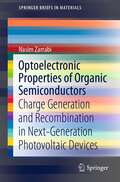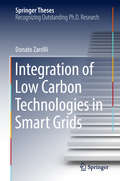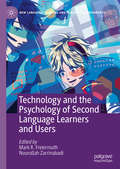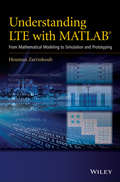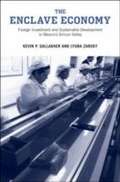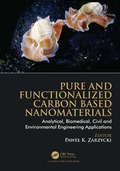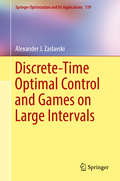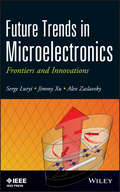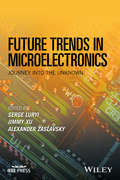- Table View
- List View
Digital Transformation and New Challenges: Digitalization of Society, Economics, Management and Education (Lecture Notes in Information Systems and Organisation #40)
by Evgeny Zaramenskikh Alena FedorovaThis book gathers the best papers presented at the first conference held by the Russian chapter of the Association for Information Systems (AIS). It shares the latest insights into various aspects of the digitalization of the economy and the consequences of transformation in public administration, business and public life. Integrating a broad range of analytical perspectives, including economic, social and, technological, this interdisciplinary book is particularly relevant for scientists, digital technology users, companies and public institutions.
Digital Transformation and New Challenges: Changes in Business and Society in the Digital Era (Lecture Notes in Information Systems and Organisation #45)
by Evgeny Zaramenskikh Alena FedorovaThis book gathers the best papers presented at the second conference held by the Russian chapter of the Association for Information Systems (AIS), which took place in Yekaterinburg, Russian Federation, in December 2019. It shares the latest insights into various aspects of the digitalization of the economy and the consequences of transformation in public administration, business and public life. Integrating a broad range of analytical perspectives, including economic, social and technological, this interdisciplinary book is particularly relevant for scientists, digital technology users, companies and public institutions.
Digitalization of Society, Economics and Management: A Digital Strategy Based on Post-pandemic Developments (Lecture Notes in Information Systems and Organisation #53)
by Evgeny Zaramenskikh Alena FedorovaThis book gathers the best papers presented at the third conference held by the Russian chapter of the Association for Information Systems (AIS), which took place in December 2021. The book shows the path to digital transformation of organizations and how possible obstacles can be overcome. With contributions from digital experts in both academia and IT and management, it presents practical frameworks and planning tools for new business models. It offers executives at the forefront of strategic initiatives a guide on how to implement key disruptive technologies in their organizations while following an established digital strategy. Overall, the book is relevant for scientists, digital technology users, companies and public institutions.
Focal-Plane Sensor-Processor Chips
by Ákos ZarándyFocal-plane sensor-processor imager devices are sensor arrays and processor arrays embedded in each other on the same silicon chip. This close coupling enables ultra-fast processing even on tiny, low power devices, because the slow and energetically expensive transfer of the large amount of sensory data is eliminated. This technology also makes it possible to produce locally adaptive sensor arrays, which can (similarly to the human retina) adapt to the large dynamics of the illumination in a single scene This book focuses on the implementation and application of state-of-the-art vision chips. It provides an overview of focal plane chip technology, smart imagers and cellular wave computers, along with numerous examples of current vision chips, 3D sensor-processor arrays and their applications. Coverage includes not only the technology behind the devices, but also their near- and mid-term research trends.
Meathooked: The History and Science of Our 2.5-Million-Year Obsession with Meat
by Marta ZaraskaA few years ago, Marta Zaraska’s mother decided to go vegetarian after stumbling upon an article on the health risks of eating meat. Her resolve lasted about a fortnight before the juicy hams and the creamy pâtés began creeping back into her refrigerator. Prodded to explain her lapse, she replied, "I like meat, I eat it, end of story. ” Many of us have had a similar experience. What makes us crave animal protein, and what makes it so hard to give up? And if all the studies are correct, and consuming meat is truly unhealthy for us, why didn’t evolution turn us all into vegetarians in the first place? In Meathooked, Zaraska explores what she calls the "meat puzzle”: our love of meat, despite its harmful effects. Scientific journals overflow with reports of red meat raising the risk of certain cancers; each hamburger contributes as much to global warming as does driving a car 320 miles; and the horrors of industrial meat production are now well-known. None of these facts have prompted us to give up our hamburgers and steaks. On the contrary, meat consumption has only increased over the past decades. Taking the reader to India’s unusual steakhouses, animal sacrifices at temples in Benin, and labs in Pennsylvania where meat is being grown in petri dishes, Zaraska examines the history and future of meat and meat-eating, showing that while our increasing consumption of meat can be attributed in part to the power of the meat industry and the policies of our governments, the main "hooks” that keep us addicted to meat are much older: genes and culture. An original and thought-provoking exploration of carnivorousness, Meathooked explains one of the most enduring features of human civilization--and why meat-eating will continue to shape our bodies and our world into the foreseeable future.
Wireless Network Simulation: A Guide using Ad Hoc Networks and the ns-3 Simulator
by Henry Zárate Ceballos Jorge Ernesto Parra Amaris Hernan Jiménez Jiménez Diego Alexis Romero Rincón Oscar Agudelo Rojas Jorge Eduardo Ortiz TriviñoLearn to run your own simulation by working with model analysis, mathematical background, simulation output data, and most importantly, a network simulator for wireless technology. This book introduces the best practices of simulator use, the techniques for analyzing simulations with artificial agents and the integration with other technologies such as Power Line Communications (PLC).Network simulation is a key technique used to test the future behavior of a network. It’s a vital development component for the development of 5G, IoT, wireless sensor networks, and many more. This book explains the scope and evolution of the technology that has led to the development of dynamic systems such as Internet of Things and fog computing. You'll focus on the ad hoc networks with stochastic behavior and dynamic nature, and the ns-3 simulator. These are useful open source tools for academics, researchers, students and engineers to deploy telecommunications experiments, proofs and new scenarios with a high degree of similarity with reality. You'll also benefit from a detailed explanation of the examples and the theoretical components needed to deploy wireless simulations or wired, if necessary.What You’ll LearnReview best practices of simulator usesUnderstand techniques for analyzing simulations with artificial agentsApply simulation techniques and experiment designProgram on ns-3 simulatorAnalyze simulation resultsCreate new modules or protocols for wired and wireless networksWho This Book Is ForUndergraduate and postgraduate students, researchers and professors interested in network simulations. This book also includes theoretical components about simulation, which are useful for those interested in discrete event simulation DES, general theory of simulation, wireless simulation and ns-3 simulator.
Proceedings of CASICAM 2022 (Springer Tracts in Additive Manufacturing)
by Khalid Zarbane Zitouni BeidouriThis book contains selected papers from the conference CASICAM'22, presenting the latest advancements and discoveries in Additive Manufacturing (AM) technology. The chapters cover a wide range of topics related to AM, including design for additive manufacturing, functionally graded additive manufacturing (FGAM), new and innovative materials for AM, AM parts/processes modeling and simulation, AM process optimization, monitoring, and qualification, 4D printing, AM post-processing operations, AM product metrology and quality control, AM standards and certification, health, safety, and environment challenges, education, training, and research strategy, and AM applications and challenges.
Take Control of Numbers (2.2)
by Sharon ZardettoAre you new to spreadsheet software, to Numbers in particular, or to Numbers 6? Have you had time to only skim the surface of the app but want to be more proficient? Are your formula-building skills limited to SUM and AVERAGE but you need more from your data? Do you wonder if it matters whether you use a line chart or a bar chart (it does!), or when a pie chart is the way to go? At the risk of sounding like an infomercial: If you answered “yes” to any of these questions, this book is for you. If you have other questions, this book is for you. If you don’t even know what questions to ask, this book is for you.
The ELFNET Book on Failure Mechanisms, Testing Methods, and Quality Issues of Lead-Free Solder Interconnects
by Christian Zardini Günter GrossmannThe ELFNET Book on Failure Mechanisms, Testing Methods, and Quality Issues of Lead-Free Solder Interconnects is the work of the European network ELFNET which was founded by the European Commission in the 6th Framework Programme. It brings together contributions from the leading European experts in lead-free soldering. The limited validity of testing methods originating from tin-lead solder was a major point of concern in ELFNET members' discussions. As a result, the network's reliability group decided to bring together the material properties of lead-free solders, as well as the basics of material science, and to discuss their influence on the procedures for accelerated testing. This has led to a matrix of failure mechanisms and their activation and, as a result, to a comprehensive coverage of the scientific background and its applications in reliability testing of lead-free solder joints. The ELFNET Book on Failure Mechanisms, Testing Methods, and Quality Issues of Lead-Free Solder Interconnects is written for scientists, engineers and researchers involved with lead-free electronics.
Integration of Renewable Energy Sources Into the Power Grid Through PowerFactory (Power Systems)
by Morteza Zare Oskouei Behnam Mohammadi-IvatlooThis book evaluates a number of serious technical challenges related to the integration of renewable energy sources into the power grid using the DIgSILENT PowerFactory power system simulation software package. It provides a fresh perspective on analyzing power systems according to renewable energy sources and how they affect power system performance in various situations. The book examines load flow, short-circuit, RMS simulation, power quality, and system reliability in the presence of renewable energy sources, and presents readers with the tools needed for modeling, simulation, and analysis for network planning. The book is a valuable resource for researchers, engineers, and students working to solve power system problems in the presence of renewable energy sources in power system operations and utilities.
SPIONs as Nano-Theranostics Agents
by Atefeh Zarepour Ali Zarrabi Arezoo KhosraviThis Brief introduces SuperParamagnetic Iron Oxide Nanoparticles (SPIONs), the different synthesis approaches, their applications in the field of diagnostics and treatment and finally as theranostic agents in cancer.
Metal Oxide Nanocomposite Thin Films for Optoelectronic Device Applications
by Rayees Ahmad ZargarMETAL OXIDE NANOCOMPOSITE THIN FILMS FOR OPTOELECTRONIC DEVICE APPLICATIONS The book provides insight into the fundamental aspects, latest research, synthesis route development, preparation, and future applications of metal oxide nanocomposite thin films. The fabrication of thin film-based materials is important to the future production of safe, efficient, and affordable energy as the devices convert sunlight into electricity. Thin film devices allow excellent interface engineering for high-performance printable solar cells as their structures are highly reliable and stand-alone systems can provide the required megawatts. They have been used as power sources in solar home systems, remote buildings, water pumping, megawatt-scale power plants, satellites, communications, and space vehicles. Metal Oxide Nanocomposite Thin Films for Optoelectronic Device Applications covers the basics of advanced nanometal oxide-based materials, their synthesis, characterization, and applications, and all the updated information on optoelectronics. Topics discussed include the implications of metal oxide thin films, which are critical for device fabrications. It provides updated information on the economic aspect and toxicity, with great focus paid to display applications, and covers some core areas of nanotechnology, which are particularly concerned with optoelectronics and the available technologies. The book concludes with insights into the role of nanotechnology and the physics behind photovoltaics. Audience The book will be an important volume for electronics and electrical engineers, nanotechnologists, materials scientists, inorganic chemists in academic research, and those in industries, exploring the applications of nanoparticles in semiconductors, power electronics, and more.
Metal Oxide–Based Carbon Nanocomposites for Environmental Remediation and Safety
by Rayees Ahmad Zargar Saleem Ahmad YatooThis book focuses on nanotechnology for the preparation of metal oxide–based carbon nanocomposite materials for environmental remediation. It analyses the use of nanomaterials for water, soil, and air solutions, emphasizing the environmental risks of pollution. It further explores how magnetic and activated carbon nanomaterials are being used for a sustainable environmental protection of water and soil, and detection of harmful gases. The status and major challenges of using carbon-based nanomaterials on a large scale are explained, supported by relevant case studies. Features: Exhaustively covers nanotechnology, metal oxide–carbon nanocomposites and their application in soil, water, and air treatments Explores pollutants nano-sensing and their remediation towards environmental safety Includes economics analysis and environmental aspects of metal oxide materials Describes why properties of oxide carbon–based nanomaterials are useful for environmental applications Discusses current case studies of remediation technologies This book is aimed at graduate students and researchers in nanotechnology, environmental technology, and remediation.
Neglected and Underutilized Crops - Towards Nutritional Security and Sustainability
by Sajad Majeed Zargar Antonio Masi Romesh Kumar SalgotraThis book covers important topics on various neglected and underutilised crops (vegetables, cereals, fruit crops). It gives an overview of the potential, availability of genetic and genomic resources, and the future prospects of these food crops. The book presents different chapters on the importance of underutilised crops with respect to sustainable agriculture and describes the approaches that must be followed for improving the yield and production of these crops. It covers a wide range of food crops such as millet, buckwheat, underutilised spices, underutilised vegetables and underutilised fruit crops. It also provides insights on what smart foods are? And, whether these neglected crops qualify as smart foods?This up-to-date and informative book is meant for food scientists, geneticists, breeders and biotechnologists. It is of interest to students, researchers and course instructors in these fields.
Cyber Republic: Reinventing Democracy in the Age of Intelligent Machines
by George ZarkadakisScience and tech expert George Zarkadakis presents an indispensable guide to making liberal democracies more inclusive, and the digital economy more equitable in the coming Fourth Industrial Revolution.Around the world, liberal democracies are in crisis. Citizens have lost faith in their government; right-wing nationalist movements frame the political debate. At the same time, economic inequality is increasing dramatically; digital technologies have created a new class of super-rich entrepreneurs. Automation threatens to transform the free economy into a zero-sum game in which capital wins and labor loses. But is this digital dystopia inevitable? In Cyber Republic, George Zarkadakis presents an alternative, outlining a plan for using technology to make liberal democracies more inclusive and the digital economy more equitable. Cyber Republic is no less than a guide for the coming Fourth Industrial Revolution.
In Our Own Image: Savior or Destroyer? The History and Future of Artificial Intelligence
by George ZarkadakisA timely and important book that explores the history and future, as well as the societal and ethical implications, of Artificial Intelligence as we approach the cusp of a fourth industrial revolution Zarkadakis explores one of humankind's oldest love-hate relationships—our ties with artificial intelligence, or AI. He traces AI's origins in ancient myth, through literary classics like Frankenstein, to today's sci-fi blockbusters, arguing that a fascination with AI is hardwired into the human psyche. He explains AI's history, technology, and potential; its manifestations in intelligent machines; its connections to neurology and consciousness, as well as—perhaps most tellingly—what AI reveals about us as human beings. In Our Own Image argues that we are on the brink of a fourth industrial revolution—poised to enter the age of Artificial Intelligence as science fiction becomes science fact. Ultimately, Zarkadakis observes, the fate of AI has profound implications for the future of science and humanity itself.
Optoelectronic Properties of Organic Semiconductors: Charge Generation and Recombination in Next-Generation Photovoltaic Devices (SpringerBriefs in Materials)
by Nasim ZarrabiThis book focuses on organic semiconductors with particular attention paid to their use as photovoltaic devices. It addresses a fundamental and hitherto overlooked concept in the field of organic optoelectronics, namely the role that sub-gap states play in the performance of organic semiconducting devices. From a technological point of view, organic semiconductor-based devices are of significant interest due to their lightweight, ease of processability, conformal flexibility, and potentially low cost and low embodied energy production. Motivated by these rather unique selling points, the performance of organic semiconductors has been a subject of multidisciplinary study for more than 60 years with steady progress in applications such as solar cells, transistors, light emitting diodes, and various sensors.The book begins with a review of the main electro-optical phenomena in organic solar cells and presents a new method for measuring exciton diffusion lengths based on a low-quencher-content device structure. Furthermore, the book reveals how mid-gap trap states are a universal feature in organic semiconductor donor–acceptor blends, unexpectedly contributing to charge generation and recombination, and having profound impact on the thermodynamic limit of organic photovoltaic devices. Featuring cutting-edge experimental observations supported with robust and novel theoretical arguments, this book delivers important new insight as to the underlying dynamics of exciton generation and diffusion, charge transfer state dissociation, and indeed the ultimate fate of photogenerated free carriers.
Integration of Low Carbon Technologies in Smart Grids (Springer Theses)
by Donato ZarrilliThe thesis provides different opportunities and ideas to face some current challenges in the electricity systems. It focuses on the effective and efficient integration of distributed low carbon technologies in the grid of the future. Planning and operation problems for different clean solutions, such as market bidding strategies for intermittent energy producers, demand side management algorithms for smart buildings, and electrical storage options for network operators, are studied for facilitating the integration of renewable energy sources in the power system chain.
Technology and the Psychology of Second Language Learners and Users (New Language Learning and Teaching Environments)
by Nourollah Zarrinabadi Mark R. FreiermuthThis edited volume brings together large-scale research as well as case studies from a range of geographical contexts and represents a variety of educational settings involving second language learners and users. Its aim is to explore the interrelated issues of psychology and technology use in second language learning settings as well as in more autonomous environments. As language learning professionals continue to devote more time and attention to making various technological tools an integral part of the classroom, it is just as important to understand the influences that these tools have on the psychological state of the learners who use them. In consideration of this objective, the volume examines factors such as learner attitudes and motivation, emotion and behaviour, and the cognitive processes that are at play in the minds of the language users. This volume will be of interest not only to language teachers but also to researchers working in second language acquisition (SLA), applied linguistics, and educational psychology.
Understanding LTE with MATLAB
by Houman ZarrinkoubAn introduction to technical details related to the Physical Layer of the LTE standard with MATLAB®The LTE (Long Term Evolution) and LTE-Advanced are among the latest mobile communications standards, designed to realize the dream of a truly global, fast, all-IP-based, secure broadband mobile access technology.This book examines the Physical Layer (PHY) of the LTE standards by incorporating three conceptual elements: an overview of the theory behind key enabling technologies; a concise discussion regarding standard specifications; and the MATLAB® algorithms needed to simulate the standard.The use of MATLAB®, a widely used technical computing language, is one of the distinguishing features of this book. Through a series of MATLAB® programs, the author explores each of the enabling technologies, pedagogically synthesizes an LTE PHY system model, and evaluates system performance at each stage. Following this step-by-step process, readers will achieve deeper understanding of LTE concepts and specifications through simulations.Key Features:* Accessible, intuitive, and progressive; one of the few books to focus primarily on the modeling, simulation, and implementation of the LTE PHY standard* Includes case studies and testbenches in MATLAB®, which build knowledge gradually and incrementally until a functional specification for the LTE PHY is attained* Accompanying Web site includes all MATLAB® programs, together with PowerPoint slides and other illustrative examplesDr Houman Zarrinkoub has served as a development manager and now as a senior product manager with MathWorks, based in Massachusetts, USA. Within his 12 years at MathWorks, he has been responsible for multiple signal processing and communications software tools. Prior to MathWorks, he was a research scientist in the Wireless Group at Nortel Networks, where he contributed to multiple standardization projects for 3G mobile technologies. He has been awarded multiple patents on topics related to computer simulations. He holds a BSc degree in Electrical Engineering from McGill University and MSc and PhD degrees in Telecommunications from the Institut Nationale de la Recherche Scientifique, in Canada.www.wiley.com/go/zarrinkoub
The Enclave Economy: Foreign Investment and Sustainable Development in Mexico's Silicon Valley
by Lyuba Zarsky Kevin P. GallagherForeign investment has been widely perceived as a panacea for developing countries--as a way to reduce poverty and jump-start sustainable modern industries. In The Enclave Economy,Kevin Gallagher and Lyuba Zarsky call this prescription into question, showing that Mexico's post-NAFTA experience of foreign direct investment in its information technology sector, particularly in the Guadalajara region, did not result in the expected benefits. Charting the rise and fall of Mexico's "Silicon Valley," they explore issues that resonate through much of Latin America and the developing world: the social, economic, and environmental effects of market-driven globalization. In the 1990s, Mexico was a poster child for globalization, throwing open its borders to trade and foreign investment, embracing NAFTA, and ending the government's role in strengthening domestic industry. But The Enclave Economyshows that although Mexico was initially successful in attracting multinational corporations, foreign investments waned in the absence of active government support and because China became increasingly competitive. Moreover, foreign investment created an "enclave economy" the benefits of which were confined to an international sector not connected to the wider Mexican economy. In fact, foreign investment put many local IT firms out of business and transferred only limited amounts of environmentally sound technology. Gallagher and Zarsky suggest policies and strategies that will enable Mexico and other developing countries to foster foreign investment for sustainable development in the future.
Pure and Functionalized Carbon Based Nanomaterials: Analytical, Biomedical, Civil and Environmental Engineering Applications
by Paweł K. ZarzyckiThis book describes in a comprehensive manner latest studies conducted by various research groups worldwide focusing on carbon and related nanomaterials. Fourteen chapters of this book deal with a number of key research topics and applications of pure and functionalized carbon nanomaterials and their hybrid nanocomposites. Specifically, the authors have presented interdisciplinary investigations including: (i) carbon nanoparticles and layers synthesis, (ii) analytical aspects of carbon nanomaterials and their characterisation under different conditions as well as (iii) various applications of carbon nanoparticles. They have reported and summarised key applications of carbon particles or nanoobjects in pharmacy, biomedicine, agriculture and food industry, water treatment, physicochemical analysis, optoelectronics, electronic and magnetic materials for supercapacitors or radar adsorbing materials, tribology, chromatography, electrophoresis, bioanalysis, nanobiocatalysis, biofuels production as well as environmental remediation.
Discrete-Time Optimal Control and Games on Large Intervals
by Alexander J. ZaslavskiDevoted to the structure of approximate solutions of discrete-time optimal control problems and approximate solutions of dynamic discrete-time two-player zero-sum games, this book presents results on properties of approximate solutions in an interval that is independent lengthwise, for all sufficiently large intervals. Results concerning the so-called turnpike property of optimal control problems and zero-sum games in the regions close to the endpoints of the time intervals are the main focus of this book. The description of the structure of approximate solutions on sufficiently large intervals and its stability will interest graduate students and mathematicians in optimal control and game theory, engineering, and economics. This book begins with a brief overview and moves on to analyze the structure of approximate solutions of autonomous nonconcave discrete-time optimal control Lagrange problems. Next the structures of approximate solutions of autonomous discrete-time optimal control problems that are discrete-time analogs of Bolza problems in calculus of variations are studied. The structures of approximate solutions of two-player zero-sum games are analyzed through standard convexity-concavity assumptions. Finally, turnpike properties for approximate solutions in a class of nonautonomic dynamic discrete-time games with convexity-concavity assumptions are examined.
Future Trends in Microelectronics
by Alexander Zaslavsky Serge Luryi Jimmy XuLeaders in the field predict the future of the microelectronics industryThis seventh volume of Future Trends in Microelectronics summarizes and synthesizes the latest high-level scientific discussions to emerge from the Future Trends in Microelectronics international workshop, which has occurred every three years since 1995. It covers the full scope of cutting-edge topics in microelectronics, from new physical principles (quantum computing, correlated electrons), to new materials (piezoelectric nanostructures, terahertz plasmas), to emerging device technologies (embedded magnetic memories, spin lasers, and biocompatible microelectronics).An ideal book for microelectronics professionals and students alike, this volume of Future Trends in Microelectronics:Identifies the direction in which microelectronics is headed, enabling readers to move forward with research in an informed, efficient, and profitable mannerIncludes twenty-nine contributor chapters by international authorities from leading universities, major semiconductor companies, and government laboratoriesProvides a unified, cohesive exploration of various trends in microelectronics, looking to future opportunities, rather than past successes
Future Trends in Microelectronics: Journey into the Unknown
by Alexander Zaslavsky Jimmy Xu Serge LuryiPresents the developments in microelectronic-related fields, with comprehensive insight from a number of leading industry professionals The book presents the future developments and innovations in the developing field of microelectronics. The book's chapters contain contributions from various authors, all of whom are leading industry professionals affiliated either with top universities, major semiconductor companies, or government laboratories, discussing the evolution of their profession. A wide range of microelectronic-related fields are examined, including solid-state electronics, material science, optoelectronics, bioelectronics, and renewable energies. The topics covered range from fundamental physical principles, materials and device technologies, and major new market opportunities. Describes the expansion of the field into hot topics such as energy (photovoltaics) and medicine (bio-nanotechnology) Provides contributions from leading industry professionals in semiconductor micro- and nano-electronics Discusses the importance of micro- and nano-electronics in today's rapidly changing and expanding information society Future Trends in Microelectronics: Journey into the Unknown is written for industry professionals and graduate students in engineering, physics, and nanotechnology. Serge Luryi, PhD, is a Distinguished Professor and Chair of Electrical and Computer Engineering at Stony Brook University, as well as the Director of New York State Center for Advanced Technology in Sensor Systems. He has worked in microelectronics for over 30 years, published over 250 papers and has been awarded 53 US patents. He is a Fellow of the IEEE, of the American Physical Society, and of the Optical Society of America. Jimmy Xu, PhD, is the Charles C. Tillinghast Jr. '32 University Professor of Engineering and Physics at Brown University. Prior to 1999, he was the James Ham Chair of Optoelectronics, as well as the Director of the Nortel Institute for Telecommunications at the University of Toronto. He has worked in microelectronics for over 30 years. He is a Fellow of the AAAS, APS, Guggenheim Foundation, IEEE, and the Institute of Physics. Alex Zaslavsky, PhD, is a Professor of Engineering and Physics at Brown University. During 2009-2012 he was a Visiting Senior Chair of Excellence at the Nanosciences Foundation in Grenoble, France. He has worked in microelectronics for over 25 years and has published over 130 journal papers and book chapters. He has been an editor of the Solid State Electronics international journal since 2003.
